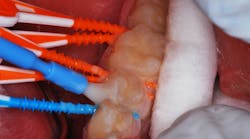Radiographic verification of silver diammine fluoride action on proximal dental carious lesions in a teenager
Applying silver diammine fluoride (SDF) with a dental soft pick to contacting proximal tooth surfaces attenuates the progress of caries lesions. (Note: The accurate spelling of diammine contains two m’s. The word is commonly misspelled with only one m.) This brief report describes that method and documents it with bitewing radiographs, 19 months’ results in a teenager—13 months after one application, followed by a second application six months later.
Soaking the proximal tooth surface caries lesions with 38% SDF solution delivered with soft dental picks has been described in the literature.1-3 Efficacy of uptake of the solution by such lesions was shown in a simple model using extracted teeth embedded in dental stone with a leather shoelace placed interproximally in the model to simulate soft tissue.2 The clinical method for dental soft pick soaking of contacting proximal surface caries lesions can be summarized and shown as follows (figures 1–5):Identify beginning caries lesions radiographically.
success when those sites are routinely cleared of food debris and oral bacteria.
References
THEODORE P. CROLL, DDS, a diplomate of the American Board of Pediatric Dentistry, is clinic director of Cavity Busters in Doylestown, Pennsylvania. He currently serves as adjunctive clinical professor of pediatric dentistry at the University of Texas Health Science Center in San Antonio as well as clinical professor of pediatric dentistry at Case Western Reserve School of Dental Medicine in Cleveland, Ohio.
JOEL H. BERG, DDS, MS, is a consultant in the dental industry and practices pediatric dentistry part-time. He is former dean at the University of Washington School of Dentistry and a past-president of both the American Academy of Pediatric Dentistry and the American Academy of Esthetic Dentistry. His career has placed him in leadership roles across the profession in the dental industry, academics, organized dentistry, and in private practice.














